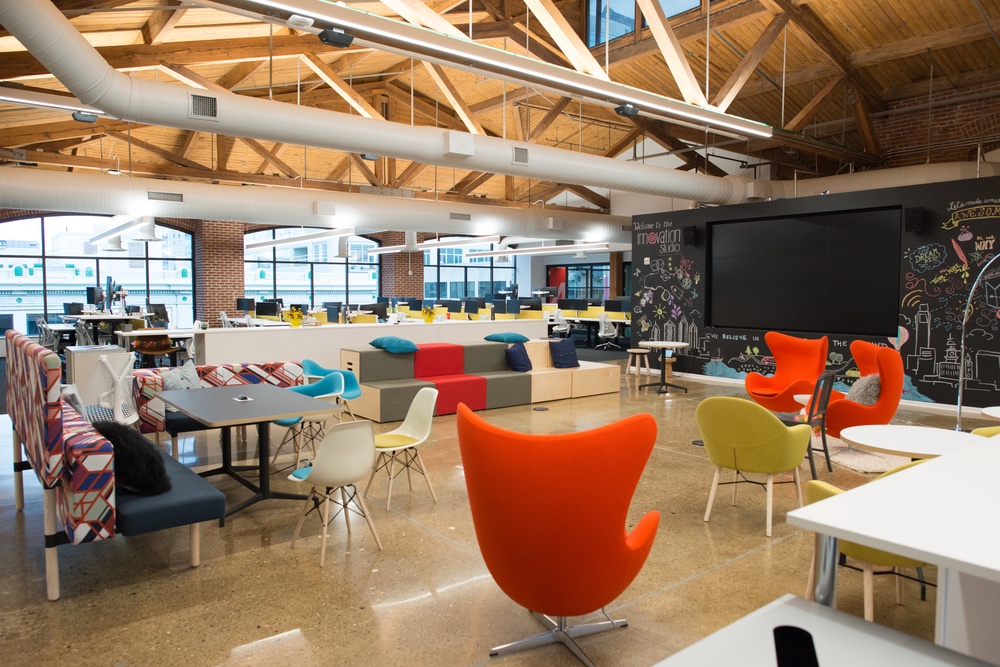In recent years, coworking has become an increasingly popular way for individuals and businesses to operate, and as of 2022 there were around 19,400 coworking spaces globally.
How can we get the most out of these spaces? And, relating to the design, what aspects of the space are important to maximising productivity, appealing to as many different working styles as possible, as well as enhancing wellbeing and inspiring user creativity?
What is Coworking?
First, we need to understand exactly what coworking is. Coworking is a type of working space in which people from different teams and companies come together to work in a single shared space.
Using a coworking space can have many benefits, both on an individual and an organisational level, and we will look at how the design and features can impact this.
Who Would Use a Coworking Space
Various businesses can use a coworking space effectively, however when launched in the early 2000s, they would mainly attract solo workers and web entrepreneurs.
They can be a good fit for businesses entering new markets, those who don’t want to the risk of a long-term lease, as well as by companies who are seeking to cut down on large amounts of unused office space, as remote working increases.
As well as the traditional start-ups and sole traders utilising the spaces, users now also include well-known and even multi-national, global organisations.
Important Features of a Coworking Space
To ensure users get all of the benefits out of a coworking space, there are elements that need to be considered in relation to how they look and the facilities they contain.
Types and design of workspaces are important
The core functionality of a coworking space is as a place to work, and it is paramount that this aspect is the focus.
It is vital to have quieter areas, as even in a shared space there are times where individuals will need to focus on something intensely. There should also be areas in which workers can take private and confidential calls, so consider a soundproofed booth, away from the rest of the space.
Also important is having practical spaces to work – i.e., making sure there are sufficient sockets to plug in laptops and chargers. Consider usability, but also the finish and design – for example making sure that any fixtures and fittings, including the sockets and any electrical enclosure boxes are of the highest standard and finish.
For everyone it is important to have practical places to work, different seating types and even features like beanbags and steps can all provide places for optimum productivity. Natural lighting throughout has many benefits, including creating a welcoming atmosphere, enhancing vitamin D and energy levels and generally elevating workplace satisfaction.
A change in scenery from the normal desk can increase productivity – 69% of office workers say that their productivity increases if they are able to work in a variety of settings throughout the day. This can also open the door to collaboration with others in the space – a potential breeding ground for a fresh set of ideas.
A meeting of minds
As well as ensuring individuals have enough practical spaces to work, a coworking space should also have areas or rooms for team meetings.
Just like the working areas, meeting room offerings should vary. There is a place for the more traditional meeting room, but consideration should also be given to booths, sofas and spaces in a kitchen or foyer, where teams can break out and discuss ideas.
As well as a range of designs, think about alternative sized meeting rooms to cope with different teams, to help reduce the risk of larger spaces being wasted for smaller teams, and vice versa – large teams being unable to find a suitable space.
Facilities and collaboration
With workstations and meeting rooms covered off; attention should be given to what other facilities your space will contain, as well as the emphasis on the collaboration.
Just as a kitchen area can become the heart of the home, a well thought out kitchen in a coworking environment can become one of the most important and collaborative places.
When teams are making teas and coffees, as well as lunches, this can be a source of interaction and spark a conversation.
As well as potentially developing ideas for work, interaction can boost the social aspect – 79% of users say that being in a coworking environment expanded their social networks, with 83% feeling less lonely.
A nice kitchen area could couple as a meeting and breakout space and could be where company updates and briefings are held.
Coffee machines, water coolers fresh fruit or even beer fridges can encourage people to leave their desks and contribute towards creating a collaborative culture. Again, ensure enough power sockets are in place, to allow people to work in these spaces too.
Offering a comfortable working environment is an essential aspect of the coworking space. With the right facilities, design and ethos, your coworking space can become a collaborative location for business to thrive.
Sources
33 Captivating Coworking Statistics [2023]: Facts And Trends You Need To Know – Zippia
What is coworking? (wework.com)]
25 Trending Remote Work Statistics [2023]: Facts, Trends, And Projections – Zippia
Meeting Rooms for Hire in London | TOG (theofficegroup.com)
The kitchen is the heart of the home | BBC Good Food
9 Benefits of Natural Light in the Workplace (Office Spaces) (avantisystemsusa.com)


No comments yet